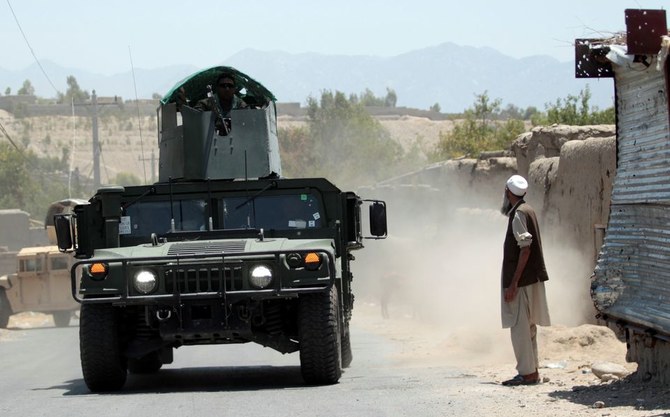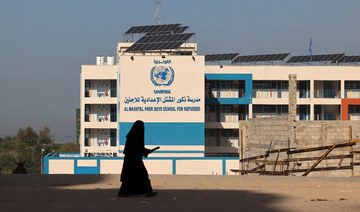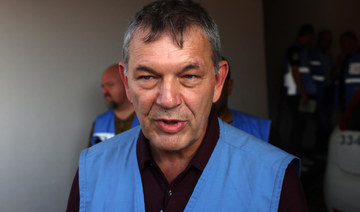KABUL: Taliban fighters seized control on Thursday of a key district in western Afghanistan that includes a major border crossing with Iran, Afghan security officials said, as the insurgents continued their rapid military advances around the country.
In the last week, the Taliban have overrun areas bordering five countries — Iran, Tajikistan, Turkmenistan, China and Pakistan — as foreign forces end their two-decade intervention and the domestic security situation deteriorates.
Pitched battles between Taliban fighters and Afghan government forces were also underway in the northern Balkh province bordering Uzbekistan.
Two senior security officials told Reuters on condition of anonymity that the Islam Qala border crossing with Iran, located in Herat province, had fallen to the Taliban and that Afghan security and customs officials had fled across the border.
Al Alalam TV, Iran’s official Arabic language service, also reported that Afghan soldiers had entered Iranian territory via the border crossing to escape the Taliban.
Tariq Arian, spokesman for the Afghan interior ministry, denied the reports and said the border crossing was still under the control of government forces.
Calls by Reuters to the offices of the provincial governor and police went unanswered.
Another security official said Taliban fighters had seized five districts in Herat without a fight.
Earlier this week, more than 1,000 Afghan security personnel fled into Tajikistan as the Taliban captured most of the northern province of Badakhshan, which also borders China and Pakistan.
CLASHES IN WESTERN PROVINCE
The defense ministry said Afghan government forces earlier on Thursday wrested back control of Qala-e-Naw, capital of the western province of Badghis, which had been stormed by the Taliban on Wednesday.
Hundreds of troops were deployed to the region, the ministry said, adding that fighting was continuing on the fringes of Qala-e-Naw, where insurgents had earlier seized key government buildings in the city including police headquarters.
“The city is fully (back) under our control and we are conducting operations against the Taliban on the outskirts of the city,” Defense Ministry spokesman Fawad Aman said.
The ministry said 69 Taliban fighters were killed in operations on the edge of Qala-e-Naw — the first major provincial capital entered by the insurgents in their latest offensive.
The rest of Badghis province is in Taliban hands. Western security officials say the Taliban have captured more than 100 districts in Afghanistan. The Taliban say they hold over 200 districts in 34 provinces comprising over half the country. Major cities remain under government control.
The insurgents have been gaining territory for weeks but accelerated their thrust as the United States vacated its main Afghan base, effectively ending an intervention that began with the ousting of the Islamist Taliban government in 2001.
Taliban advances have been especially dramatic in northern provinces where they had long been kept at bay.
Stop-start peace talks between the government and insurgents remain inconclusive. Taliban delegations visited Iran on Wednesday and were in Moscow on Thursday.
Defending the decision to pull US forces out of Afghanistan, President Joe Biden said on Thursday he did not expect the Taliban to take over the whole country and that he trusted the Afghan military.
“We’re ending America’s longest war,” he said.
Taliban fighters capture key Afghan border crossing with Iran
https://arab.news/6vagf
Taliban fighters capture key Afghan border crossing with Iran

- In last week, Taliban have overrun areas bordering five countries, Iran, Tajikistan, Turkmenistan, China and Pakistan
- Pitched battles between Taliban and Afghan forces underway in northern Balkh province bordering Uzbekistan
Three Spanish, three Afghans killed in shooting in Afghanistan

- The group were fired on while walking through a market in the mountainous city of Bamiyan
- Among eight others wounded, four were foreigners from Norway, Australia, Lithuania and Spain
KABUL: The bodies of three Spanish tourists and three Afghans shot dead while on a tour in Afghanistan were transported to the capital along with multiple wounded, the Taliban government said Saturday.
The group were fired on while walking through a market in the mountainous city of Bamiyan in central Afghanistan, around 180 kilometers (100 miles) from the capital Kabul, on Friday evening.
“All dead bodies have been shifted to Kabul and are in the forensic department and the wounded are also in Kabul. Both dead and wounded include women,” the government’s interior ministry spokesman Abdul Mateen Qani told AFP.
“Among the eight wounded, of whom four are foreigners, only one elderly foreign woman is not in a very stable situation.”
Qani said the death toll had risen to six, including two Afghan civilians and one Taliban member.
Spain’s foreign ministry on Friday announced that three of the dead were Spanish tourists, adding that at least one other Spanish national was wounded.
According to preliminary information provided by hospital sources, the wounded were from Norway, Australia, Lithuania and Spain.
“They were roaming in the bazaar when they were attacked,” Qani added.
“Seven suspects have been arrested of which one is wounded, the investigation is still going on and the Islamic Emirate is seriously looking into the matter.”
He did not say if there had been multiple shooters.
Spanish Prime Minister Pedro Sanchez posted on X, formerly Twitter: “Overwhelmed by the news of the murder of Spanish tourists in Afghanistan.”
The European Union condemned the attack “in the strongest terms.”
“Our thoughts are with the families and loved ones of the victims who lost their lives and those injured in the attack,” the bloc said in a statement.
The Taliban government, which took power in 2021 after a decade-long insurgency against foreign forces, has yet to be officially recognized by any government.
It has, however, supported a fledgling tourism sector, with more than 5,000 foreign tourists visiting Afghanistan in 2023, according to official figures.
Tourists holiday without consular support, after most embassies were evacuated, and many Western nations advise against all travel to the country, warning of kidnap and attack risks.
Alongside security concerns, the country has limited road infrastructure and a dilapidated health service.
Bamiyan is Afghanistan’s top tourist destination, known for turquoise lakes and striking mountains, and once home to the giant Buddha statues that were blown up by the Taliban in 2001 during their previous rule.
The number of bombings and suicide attacks in Afghanistan has reduced dramatically since the Taliban authorities took power and deadly attacks on foreigners are rare.
However, a number of armed groups, including the Daesh group, remain a threat.
The jihadist group has waged a campaign of attacks on foreign interests in a bid to weaken the Taliban government, targeting Pakistan and Russian embassies as well as Chinese businessmen.
Austria to resume aid to UN agency for Palestinians

- Many countries, including Germany, Sweden, Canada and Japan, had resumed funding
- A total of 3.4 million euros ($3.7 million) in funds have been budgeted for 2024
VIENNA: Austria said Saturday it will restore its funding to the UN agency for Palestinian refugees after suspending it over allegations that staff were involved in the October 7 Hamas attacks.
Israel alleged in January that some United Nations Relief and Works Agency (UNRWA) employees may have participated in the Hamas attacks on October 7 that triggered the war in the Gaza Strip.
In the weeks that followed, numerous donor states, including Austria, suspended or paused some $450 million in funding.
Many, including Germany, Sweden, Canada and Japan, had since resumed funding, while others have continued to hold out.
“After analizing the action plan in detail” submitted by UNRWA “to improve the functioning of the organization,” Austria has decided to “release the funds,” its foreign ministry said in a statement.
A total of 3.4 million euros ($3.7 million) in funds have been budgeted for 2024, and the first payment is expected to be made in the summer, the statement said.
“Some of the Austrian funds will be used in the future to improve internal control mechanisms at UNRWA,” it added.
Austria said it will “closely monitor” the implementation of the action plan with other international partners, noting that “a lot of trust had been squandered.”
The Alpine country said it has substantially increased support for the suffering Palestinian population in Gaza and the region since 7 October, making 32 million euros ($34.8 million) in humanitarian aid available to other international aid organizations.
The Hamas attack on October 7 resulted in the death of more than 1,170 people in Israel, most of them civilians, according to an AFP tally based on official Israeli figures.
Israel’s campaign in Gaza has since killed at least 35,303 people, also mostly civilians, according to data provided by the health ministry in the Hamas-run territory.
Flash floods kill at least 50 people in western Afghanistan

- Death toll was based on preliminary reports and might rise
- Hard-hit province of Ghor has suffered significant financial losses
ISLAMABAD: Flash floods from heavy seasonal rains in western Afghanistan have killed at least 50 people and dozens remain missing, a Taliban official said on Saturday, adding the death toll was based on preliminary reports and might rise.
Afghanistan has been witnessing unusually heavy seasonal rains.
The hard-hit province of Ghor has suffered significant financial losses, said Abdul Wahid Hamas, spokesman for the provincial governor, after thousands of homes and properties were damaged and hundreds of hectares of agricultural land destroyed following Friday’s floods, including the capital city Feroz Koh.
The Taliban’s government chief spokesman posted on social platform X, mourning “the loss of our fellow Afghans,” and urged ” responsible authorities ... to provide all necessary support to alleviate the suffering.” He also called on “our benevolent donors” to help and humanitarian organizations to provide the affected communities with aid.
Last week, the UN food agency said the exceptionally heavy rains in Afghanistan have killed more than 300 people and destroyed thousands of houses, mostly in the northern province of Baghlan, which bore the brunt of floods on May 10th.
Survivors have been left with no home, no land, and no source of livelihood, the World Food Organization said. Most of Baghlan is “inaccessible by trucks,” said WFP, adding that it is resorting to every alternative it can think of to deliver food to the survivors.
The latest disaster came on the heels of devastating floods that killed at least 70 people in April. The waters also destroyed about 2,000 homes, three mosques and four schools in western Farah and Herat, and southern Zabul and Kandahar provinces.
Nearly 10,000 evacuated in Ukraine’s Kharkiv region: governor

- Ukrainian President Volodymyr Zelensky plays down Russia’s gains in the offensive
- Moscow has been attacking several settlements including Vovchansk, just five kilometers from the border
KYIV: Nearly 10,000 people have been forced to leave their homes in Ukraine’s northeastern Kharkiv region since a ground attack launched by Russian forces on May 10, the regional governor said.
The assault may only be the first wave of a wider offensive, Ukrainian President Volodymyr Zelensky said.
Over a week after its launch, “a total of 9,907 people have been evacuated,” governor Oleg Synegubov said.
They were fleeing Russian soldiers who managed to advance between five to 10 kilometers (three to six miles) along the northeastern border before being stopped by Ukrainian forces.
Synegubov said Ukraine’s armed forces had repelled two attempts to break through defenses overnight.
The situation was “under control” with “defenders in certain areas conducting assault... and combing operations.”
Moscow has been attacking several settlements including Vovchansk, just five kilometers from the border.
“In the area of the city of Vovchansk, Ukrainian troops are reinforcing their defense,” Synegubov said.
A day earlier, he said Russian forces have started to destroy Vovchansk and all but 200 of its residents have fled due to fighting.
Russian forces have taken 278 square kilometers (107 square miles) between May 9 and 15, their biggest gains since the end of 2022, AFP calculated using data from the Institute for the Study of War (ISW).
Russia’s offensive “could consist in several waves. There was the first wave” in the Kharkiv region, Zelensky said journalists.
Zelensky played down Russia’s gains in the offensive but added: “We have to be sober and understand that they are going deeper into our territory. Not vice versa. And that’s still their advantage.”
Speaking about the offensive during a visit to China on Friday, Russian President Vladimir Putin said it was a response to Ukraine shelling border regions.
Nepal latest to ban Indian spice brands over safety concerns

- Hong Kong, Singapore last month banned products from Everest and MDH after tests detected presence of ethylene oxide
- Besides its use as a pesticide, ethylene oxide is used to sterilize medical equipment and as a sterilising agent in spices
KATMANDU: Nepal has become the latest jurisdiction to ban the import and sale of two popular Indian spice brands after reports that some of their products contained a cancer-causing pesticide, officials said Friday.
Hong Kong and Singapore last month banned products from Everest and MDH — two brands popular in India and exported worldwide — after tests detected the presence of ethylene oxide, according to media reports.
Besides its use as a pesticide, ethylene oxide is used to sterilize medical equipment and as a sterilising agent in spices to prevent illnesses caused by salmonella and E. Coli bacteria.
Regular exposure to the colorless and odourless compound increases the “risk of cancers of the white blood cells,” according to the US Environmental Protection Agency.
Matina Joshi Vaidya, chief of Nepal’s Department of Food Technology and Quality Control, told AFP that the Himalayan country had also decided to halt the sale of the spice blends.
“It is an issue of public health,” she said. “We have its banned import and sale from Thursday.”
Nepal has banned four products — three variants produced by MDH and one by Everest.
“We do not have the lab resources to run the tests in the country. The ban will be lifted when Indian authorities declare it safe,” Vaidya said.
Everest and MDH are India’s top two spice brands with a market share of 16 and 10 percent respectively in 2022, according to consumer research monitor Statista.
Both companies have put out statements denying their products pose a health hazard to consumers after the Singapore and Hong Kong import bans.
“We clarify and state unequivocally that these claims are untrue and lack any substantiating evidence,” MDH said last month on social media platform X.
India’s food regulation agency has asked for state authorities to carry out random testing of spice products, broadcaster NDTV reported.
















